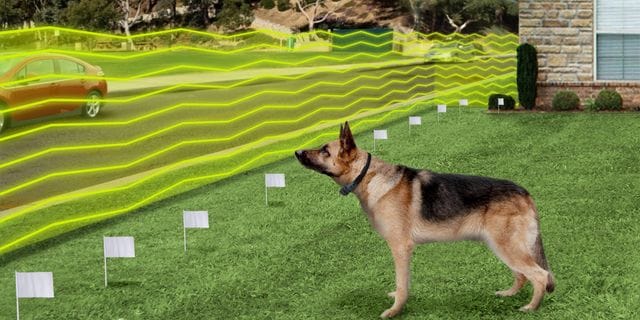An electric dog fence, also known as an invisible fence or a pet containment system, is a technology-based boundary system designed for pet containment without the need for a physical barrier. At its core, this system utilizes a combination of electronic signals, boundary wires (in some models), and a receiver collar worn by the dog.
When the pet approaches the defined boundary, the collar receives a signal and typically emits a warning sound followed by a mild electric shock if the pet continues closer to the boundary. This system is designed to safely and humanely discourage pets from straying beyond the confines of a predetermined area, such as a yard or a specific outdoor space.

Brief Overview of Its Purpose and Benefits
The primary purpose of an electric dog fence is to keep pets safe and secure within a designated area without the need for traditional fencing. This technology offers several benefits:
- Flexibility in Landscaping: Unlike physical fences, electric dog fences do not obstruct views or require significant alterations to the landscape. They can be customized to fit various property sizes and shapes.
- Cost-Effectiveness: Generally, these systems are more affordable than building and maintaining a physical fence, especially for large areas.
- Safety for Pets: By keeping pets confined to a safe area, these fences help prevent accidents like road incidents or encounters with wildlife.
- Behavioral Training: The use of an electric fence can also aid in behavioral training for pets, teaching them to respect boundaries and stay within safe limits.
In the following sections, we will delve deeper into the history, operation, types, and considerations surrounding the use of electric dog fences, offering a comprehensive understanding of this innovative pet containment solution.
History and Development of Electric Dog Fences
Origins of the Concept
The concept of electric dog fences originated in the early 1970s. Richard Peck, an American inventor, is credited with the creation of the first commercial electric dog fence. His motivation was to develop a system that would keep pets safely contained in their owner’s property without obstructing the view with physical barriers. The initial idea was simple yet innovative – using a buried wire to transmit a radio signal to a receiver collar worn by the pet. This invention was a breakthrough in pet containment solutions, offering an alternative to traditional fencing.
Evolution of Technology Over the Years
Over the decades, the technology behind electric dog fences has evolved significantly. The early models were quite basic, consisting of a wire that had to be buried around the perimeter of a property and a bulky collar for the pet. As technology advanced, these systems became more sophisticated and user-friendly. Improvements included:
- Adjustable Correction Levels: Modern collars allow owners to set the level of correction their pet receives, ensuring it's humane and appropriate for the pet’s size and temperament.
- Battery Backup and Power Failure Alerts: To ensure continuous operation, newer models often include battery backups and alerts to inform owners of power failures or malfunctions.
- Breakage Alerts: Advanced systems can detect and alert owners to any breaks or faults in the boundary wire.
Current State and Varieties
Today, electric dog fences come in various forms, catering to a range of needs and preferences:
- Wired Electric Dog Fences: These require the installation of a wire around the perimeter, which can be buried or attached to an existing physical fence. They are known for their reliability and ability to customize the shape of the boundary.
- Wireless Electric Dog Fences: These systems use a central transmitter to create a circular boundary around a property. They are easier to install but offer less flexibility in shaping the boundary.
- GPS-Based Electric Dog Fences: The latest innovation in this area, GPS-based systems, do not require any installation of wires or transmitters. They use GPS coordinates to define the containment area, offering unparalleled flexibility, especially in large, open spaces.
Each type of electric dog fence has its own set of features, advantages, and limitations, which have evolved from the initial concept to accommodate the diverse needs of pet owners and their environments.

How Electric Dog Fences Work
The Transmitter
The transmitter is the central unit of an electric dog fence. It emits a radio signal that travels through the boundary wire or, in the case of wireless systems, directly into the surrounding area. The strength, range, and frequency of this signal can often be adjusted based on the specific requirements of the property and the pet.
The Receiver Collar
This is a crucial component worn by the pet. The collar is equipped with a receiver that detects the signal emitted by the transmitter. When the pet approaches the boundary, the collar responds to the signal strength, which varies depending on the distance from the boundary line.
Boundary Wires (if applicable)
For wired electric dog fences, boundary wires are laid out along the perimeter of the desired containment area. These wires carry the signal from the transmitter and create the invisible boundary. The wire can be buried underground or attached to an existing fence.
Installation Process
- Wired Systems: Installation involves planning the layout, digging shallow trenches to bury the boundary wires, and setting up the transmitter in a dry, protected area.
- Wireless Systems: These require minimal installation, often just the placement of a central transmitter unit in a suitable location and setting the desired radius of the containment area.
- GPS-Based Systems: These involve configuring the containment area using GPS coordinates, usually through a digital interface or a mobile app.
Mechanism of Operation
Signal Transmission
In wired systems, the transmitter sends a continuous signal through the boundary wire, creating an invisible fence. In wireless and GPS-based systems, the signal forms a circular or custom-shaped boundary around the transmitter or specified coordinates.
Receiver Collar Response
As the pet approaches the boundary, the receiver collar detects the weakening or changing signal. Initially, it typically emits a warning beep. If the pet continues closer to the boundary, the collar then delivers a mild electric shock. This is meant to startle, not harm, and serves as a deterrent.
Safety Features
Modern electric dog fences include several safety features:
- Adjustable Correction Levels: Allows customization of the strength of the corrective stimulus based on the pet’s size and sensitivity.
- Audible Warnings: Before any shock is delivered, a warning beep sounds to give the pet a chance to retreat.
- Anti-Linger Feature: Prevents the pet from draining the collar battery by lingering near the boundary.
- Automatic Shut-Off: Most collars have a safety feature where the correction stops after a certain period to prevent over-correction in case the pet becomes stuck in the boundary area.

Types of Electric Dog Fences
Wired Electric Dog Fences
- Description: Wired electric dog fences involve laying a wire around the perimeter of the area where the pet is to be contained. This wire connects to a transmitter which sends a radio signal through the wire.
- Advantages:
- Customizable boundary: Can be shaped to fit any yard size or configuration.
- Consistent signal: Less prone to interference compared to wireless systems.
- Disadvantages:
- Installation effort: Requires burying or attaching the wire to an existing fence.
- Fixed location: Once installed, changing the boundary is time-consuming.
Wireless Electric Dog Fences
- Description: These systems use a central transmitter to create a circular boundary. The pet wears a receiver collar that responds when it approaches the boundary limit.
- Advantages:
- Easy installation: No wires to bury, making setup quick and straightforward.
- Portability: Ideal for people who move frequently or want to use it in different locations.
- Disadvantages:
- Limited shape: Only creates a circular boundary, which might not suit all property layouts.
- Signal variability: Obstructions like buildings or trees can interfere with the signal.
GPS-based Electric Dog Fences
- Description: These systems use GPS technology to set the boundaries of the containment area. The collar communicates with GPS satellites to determine the pet's location.
- Advantages:
- Flexibility in boundary creation: Can set boundaries in any shape or size without physical installation.
- Portability and scalability: Ideal for very large areas or open spaces.
- Disadvantages:
- Dependence on GPS signal: Requires a clear line of sight to satellites, which can be affected by weather or obstructions.
- Battery life: GPS collars typically consume more battery power than other types.
Comparison of Types
- Customization of Boundary: Wired systems offer the highest level of customization, while wireless systems are limited to circular boundaries. GPS-based systems provide flexibility but are dependent on satellite signals.
- Installation and Portability: Wireless and GPS-based systems are more portable and easier to install compared to wired systems, which require physical installation of boundary wires.
- Reliability and Signal Interference: Wired systems are generally more reliable with consistent signals. Wireless and GPS-based systems can experience interference from physical obstructions or satellite signal issues.
- Suitability for Terrain: Wired systems work well in uneven terrain or areas with lots of obstructions. Wireless systems are better suited for flat, open areas, and GPS-based systems require a clear view of the sky.

Spotlight on Fi: A Modern Take on Electric Dog Fences
As we explore the landscape of electric dog fences, it's essential to highlight innovative products like Fi, which represent the next step in pet containment and safety technology. Fi stands out in the market for its advanced features and integration of GPS technology, fitting neatly into the category of GPS-based electric dog fences.
Overview of Fi
Fi is a cutting-edge solution in the realm of pet containment and safety. Unlike traditional electric dog fences, Fi relies heavily on GPS and other technologies to offer a unique and flexible system for pet owners.
Key Features of Fi
- GPS-Based Tracking: Fi utilizes GPS to keep track of your pet’s location. This feature is particularly useful for expansive outdoor areas where traditional fences might not be feasible.
- Customizable Geofences: One of the standout features of Fi is its ability to create virtual geofences. Owners can set specific boundaries within which their pet can roam. If the pet steps out of this defined area, the owner receives an alert.
- Activity Monitoring: Beyond just location tracking, Fi also monitors your pet's activity levels. This can be a valuable tool for ensuring your pet gets enough exercise and for tracking their health and fitness.
- Integration with Mobile Devices: Fi offers a user-friendly app that integrates seamlessly with smartphones. This app allows pet owners to monitor their pet’s location and activity in real time, set up safe zones, and receive alerts.
Advantages of Fi
- Flexibility and Portability: Fi doesn’t require any physical installation, making it highly flexible and portable. It’s an ideal solution for pet owners who travel or move frequently.
- Wide Coverage: As it relies on GPS, Fi can cover much larger areas than traditional electric dog fences, making it suitable for rural or large properties.
- Health and Safety: The activity monitoring feature provides an additional layer of care, helping owners keep tabs on their pet's well-being.
Considerations
- Dependence on Cellular and GPS Networks: Fi requires a strong GPS signal and cellular network to function effectively, which might be a limitation in certain remote areas.
- Subscription Model: Unlike a one-time purchase for most electric dog fences, Fi operates on a subscription model, which includes ongoing costs.
- Battery Life: Given its reliance on GPS and cellular technology, Fi’s collar may have a shorter battery life compared to simpler electric fence collars.
Fi represents a significant advancement in the field of pet containment and safety. By combining GPS tracking, activity monitoring, and mobile integration, it offers a modern, flexible, and comprehensive solution for pet owners who seek more than just a traditional electric dog fence.
Conclusion
As we conclude our exploration of electric dog fences, it’s clear that these systems have evolved significantly from their humble beginnings. From the basic wired setups to the advanced GPS-based solutions like Fi, each type of electric dog fence offers a unique blend of features tailored to meet varying needs of pet owners and their furry companions.
The journey through the history, workings, types, and modern innovations in electric dog fences reveals a common goal: to provide a safe, secure, and comfortable environment for pets while offering peace of mind to their owners. Whether it's the customizable boundaries of wired systems, the ease of wireless fences, or the advanced technology and flexibility of GPS-based solutions like Fi, there is a solution for every scenario and need.
The key takeaway is the importance of choosing a system that not only suits the physical layout of your property but also aligns with the temperament and needs of your pet. Furthermore, regardless of the type of electric dog fence chosen, proper training and responsible use are paramount to ensure the safety and well-being of your pet.
In an era where technology continues to advance and integrate into every aspect of our lives, electric dog fences stand as a testament to how innovation can enhance our ability to care for and protect our pets. As we move forward, it is likely that we will see even more sophisticated solutions, offering greater convenience, safety, and flexibility for pet containment.
In conclusion, electric dog fences, in their various forms, represent a fusion of safety, technology, and convenience. They are a powerful tool for pet owners seeking to balance the freedom and well-being of their pets with the practicalities of modern living. As we embrace these technologies, it is essential to remain mindful of their proper use and the ethical considerations involved, ensuring that our furry friends are not just contained but are also happy, healthy, and safe.